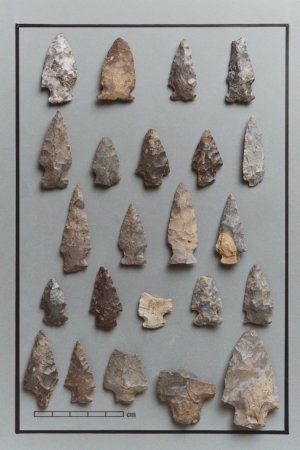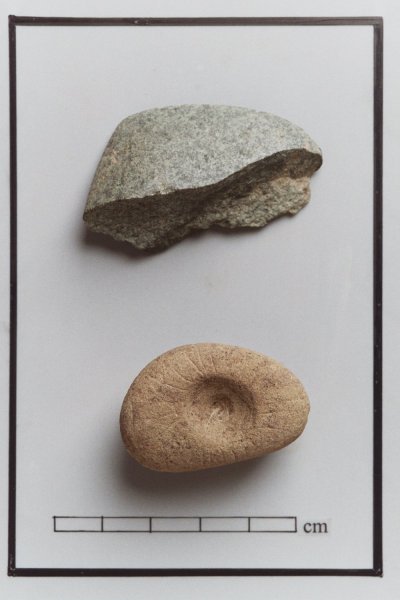Material Culture
Archaeologists recovered 3,167 pieces of chipped stone from the Allen's Creek site, including:
- cores (46 Onondaga chert and unidentified material);
- debitage (2,795 non-cortical flakes, 164 cortical flakes, 13 bipolar flakes, 60 chunk/shatter);
- 1 bifacial drill;
- 30 points (2 reworked into scrapers);
- 45 bifaces/biface fragments;
- 1 thumbnail scraper;
- 1 end scraper;
- 5 retouched pieces, 4 unifacial pieces, and 2 unifacial fragments; and
- rough stone tools, FCR, faunal and floral remains.
Lithic raw materials are primarily Onondaga chert, supplemented with an unidentified grayish/white chert. The evidence suggests that these materials were obtained from river gravel or "pebble cherts" within the immediate site area, although some may have been recovered from outcrops or till closer to the Onondaga formation 20 km north of the site.
Archaeologists recovered 30 projectile from the Allen's Creek excavations. These points include:

- 2 Brewerton and 1 Brewerton-like;
- 4 Lamoka, 1 Dustin,1 Dustin/Lamoka and 1 possible Lamoka/Dustin;
- 1 reworked Vestal, and 1 Vestal-like;
- 4 narrow, notched;
- 2 Genesee;
- 1 Snook Kill;
- 5 side-notched points;
- 2 straight stemmed points;
- 3 stemmed points (1 reworked as a scraper); and
- 1 unfinished, untyped narrow point.
These projectile point types document an almost continual occupation/re-occupation of the Allen's Creek site throughout the Late Archaic period from 3500 B.C. (Brewerton) to 1500 B.C. (Snook Kill). The B2 horizon produced the majority of diagnostic lithic artifacts. Many of these B2 horizon projectile points were recovered from features that may have originated within upper A horizon soils and are intrusive into the B2 horizon. The B1 horizon produced one Genesee projectile point. The remaining points, 1 reworked Vestal, 1 Brewerton-like, 1 narrow, notched, and 1 untyped side-notch point, were recovered from the disturbed/fill horizon directly below the road surface.
Flake attributes suggest that while an expedient technology is present at the Allen's Creek site, site occupants relied more heavily on a bifacial strategy. Crews recovered 74 bifacial tools and 15 unifacial tools from the Allen's Creek site. The presence of bifacial tools in different phases of production suggests that at least some of the tools were made on-site, and is consistent with the abundance of small late-stage flakes in the assemblages. Examples of expedient tools include utilized debitage (flakes, cores, and chunk/shatter) with edge-wear and retouched pieces. In general, heavier and larger flakes were more frequently used as tools as they would have been more advantageous for a variety of daily tasks given their durability and strength.
The similarity between the cultural layers suggests no significant lithic technological change or shift from the oldest Late Archaic occupation to the younger component. All occupations focused on a bifacial tool production strategy.
In addition to chipped stone tools, archaeologists also recovered several rough stone tools, including 5 pitted stones, 1 hammerstone, 1 stone anvil, 1 adze, and 1 partially drilled stone. Pitted stones and anvils, thought to be used for either nutting stones or anvils in bipolar reduction, refer to cobbles that display pecked or crushed areas on a relatively flat surface. Often these areas of wear form depressions. Adzes are elongated ground stone tools with highly polished, chisel-like ends used for working wood.

One highly unique piece is an incompletely drilled stone recovered from the mixed fill horizon located below the modern asphalt and subbase. This is a small cobble drilled halfway through on both sides. Around the drilled depression are incised lines, radiating outward from the center (or inward towards the center). The exact function of the stone is unknown but it falls within the category of a rare decorated.
Based on the quantity of pitted stones and nutshell at the site, it is reasonable to conclude that nuts were one of the primary resources either consumed or extracted at the site. The hammerstone, anvil, and adze recovered suggest lithic tool manufacturing/maintenance and wood working were secondary activities carried out at the site.
Top: Adze fragment. Bottom: Drilled stone with radiating incised lines.
Top: Adze fragment. Bottom: Drilled stone with radiating incised lines.